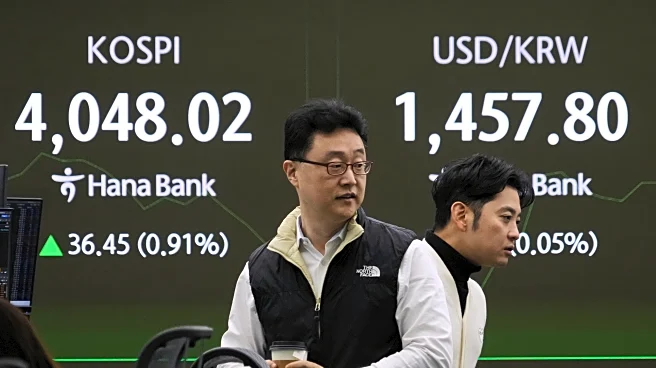What's Happening?
The U.S. stock market is experiencing a downturn, with both the S&P 500 and Nasdaq 100 falling over 1% as the trading week begins. The decline is primarily driven by weakness in the tech sector, with major
companies like Nvidia, Palantir, Apple, and AMD seeing significant losses. Additionally, the likelihood of a December rate cut has decreased, with odds dropping from 62.4% a week ago to 44.9% currently. This uncertainty is affecting investor sentiment, as lower interest rates typically stimulate economic activity by reducing borrowing costs.
Why It's Important?
The tech sector's decline is significant as it reflects broader market concerns about interest rate policies and economic growth. The reduced probability of a rate cut may lead to increased volatility and cautious investor behavior, impacting stock valuations and investment strategies. As tech companies are major drivers of market performance, their downturn could have ripple effects across other sectors, influencing overall market stability. Investors and policymakers will closely watch upcoming economic data, including the delayed September jobs report, for insights into future rate decisions and market trends.
What's Next?
The Bureau of Labor Statistics is set to release the September jobs report, which will provide crucial data for the Federal Reserve's interest rate decision. Investors will be keenly observing this report for indications of labor market health and potential policy adjustments. Kansas City Fed President Jeff Schmid has cautioned that lower rates may not address structural labor market issues, adding complexity to the Fed's decision-making process. Market participants will continue to assess economic indicators and Fed communications for guidance on future rate actions.
Beyond the Headlines
The current market dynamics highlight the intricate relationship between monetary policy and economic performance. As technological innovation and immigration policies contribute to structural labor market changes, the effectiveness of traditional rate cuts may be limited. This scenario underscores the need for comprehensive policy approaches that address underlying economic challenges, potentially influencing future fiscal and regulatory strategies.













